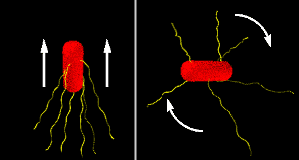Video: How Bacteria Swim and Tumble
Flagellar Motility
A motile E. coli propels itself from place to place by rotating its flagella. To move forward, the flagella rotate counterclockwise and the organism "swims". But when flagellar rotation abruptly changes to clockwise, the bacterium "tumbles" in place and seems incapable of going anywhere. Then the bacterium begins swimming again in some new, random direction.

Swimming is more frequent as the bacterium approaches a chemoattractant (food). Tumbling, hence direction change, is more frequent as the bacterium moves away from the chemoattractant. It is a complex combination of swimming and tumbling that keeps them in areas of higher food concentrations.
Some Keywords
chemoctaxis, bacteria + flagellum, cell motility, random motility, directed motility, flagellar rotation

 Connections
Connections 